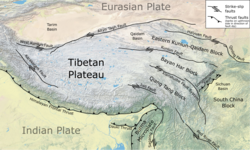1927 Gulang earthquake
| UTC time | 1927-05-22 22:32:49 |
|---|---|
| ISC event | 909273 |
| USGS-ANSS | ComCat |
| Local date | May 23, 1927 |
| Local time | 06:32 |
| Magnitude | 7.6 Mw |
| Epicenter | 37°23′N 102°19′E / 37.39°N 102.31°E |
| Fault | Haiyuan Fault |
| Areas affected | Gansu, Republic of China Xining |
| Max. intensity | MMI XI (Extreme) |
| Casualties | 40,912 |

The 1927 Gulang earthquake occurred at 06:32 a.m. on 23 May (22:32
Gulang, Gansu in the Republic of China. There were 40,912 deaths.[1] It was felt up to 700 km (435 mi) away.[2]
Geology
The
Longmenshan fault. The earthquake ruptured the complex thrust fault system in the Qilian Mountains transpressional zone, formed at a restraining bend on the Haiyuan fault.[3] Another segment of the Haiyuan fault was responsible for the 1920 Haiyuan earthquake.[4]
Damage

In the area of greatest intensity, all cave dwellings and 90% of houses were destroyed. In Gulang, almost the only thing left standing was a 20 m (66 ft) long section of the city walls and some decorated archways. In
Gulang county 4,000 people and 30,000 domestic animals were killed. In Wuwei, most of the city walls collapsed as did many temples, towers and civilian houses, 35,000 people and 200,000 horses and oxen were killed. In the area around Yongchang many primary schools, forts, stockaded villages and temples were destroyed, killing 809 people. In Shandan County more than 5,800 houses were destroyed and many cave dwellings collapsed, leaving 886 people dead.[1]
The ground was extensively fissured, with fissures up to 14 km (8.7 mi) in length, 6–13 m (20–43 ft) wide and 7 m (23 ft) deep. A large landslide at
Dongchuan buried several villages and blocked the road for a year.[1]

Characteristics
The
surface wave magnitude scale.[1] The earthquake was the result of thrust and strike-slip faults rupturing simultaneously. Three zones of surface ruptures were associated with the earthquake. Left-lateral displacements of 2.4–7.5 m (7 ft 10 in – 24 ft 7 in) occurred along a 120 km (75 mi) segment of the Lenglongling Fault. A 23 km (14 mi) long[5] rupture occurred at the eastern end of the Huangcheng–Shuangta Fault with offsets of 0.1–2.8 m (3.9 in – 9 ft 2.2 in). Rupture on the Huangcheng–Shuangta Fault comprised reverse slip. The Southern Wuwei Basin Fault produced 42 km (26 mi) of vertical offsets in the range of 0.6–2.8 m (2 ft 0 in – 9 ft 2 in).[6]
See also
References
- ^ a b c d "NOAA page on the earthquake". Archived from the original on 14 August 2017. Retrieved 12 June 2010.
- ^ USGS. "Historic Earthquakes Tsinghai, China 1927 May 21 22:32 UTC". Archived from the original on 21 June 2010. Retrieved 12 June 2010.
- doi:10.1111/j.1365-246X.1995.tb01842.x. Archived from the originalon 2 March 2012. Retrieved 12 June 2010.
- doi:10.1016/j.epsl.2008.07.057. Archived from the original(PDF) on 2011-07-21. Retrieved 12 June 2010.
- doi:10.1785/0120080282. Archived from the originalon September 19, 2010. Retrieved 17 June 2010.
- .
External links
- The International Seismological Centre has a bibliography and/or authoritative data for this event.


